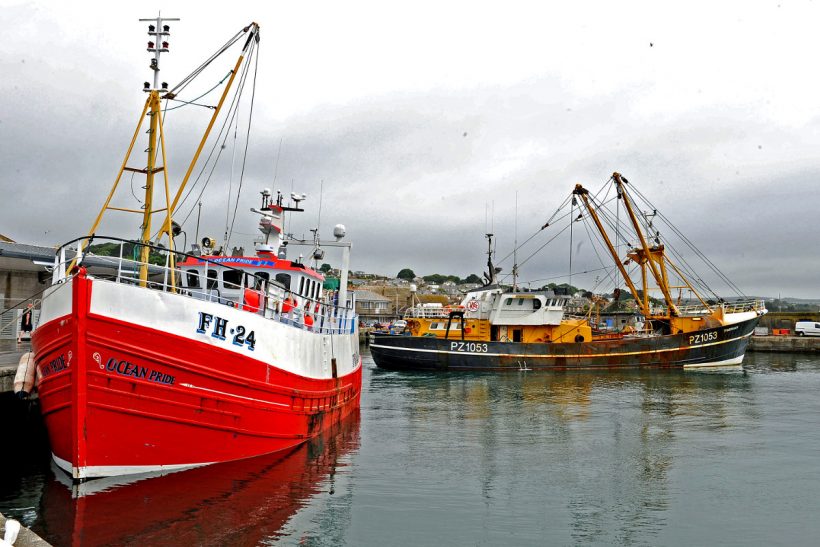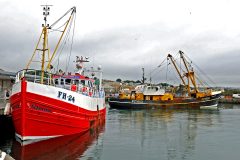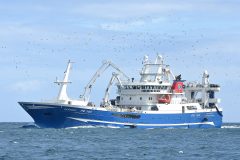Crustacean management plan under development by Cornwall IFCA
Crustacean byelaws that apply within the six-mile limit around Cornish shores are now under review, as part of the development of a shellfish management plan, says Cornwall Inshore Fisheries and Conservation Authority (Cornwall IFCA).
Based at Hayle near Newlyn, Cornwall IFCA regards the management of four main species of shellfish – brown crab, spider crab, lobster and crawfish – as ‘vitally important in order to reach a management plan that suits all stakeholders’, said chief officer Sam Davis.
Fishery officers of Cornwall IFCA are now in the early stages of developing a large-scale ‘crustacean management plan’.
Sam Davis explained: “This will include looking at all aspects of the different fisheries, not just the byelaws themselves, so we have a clear picture of what may be needed to manage them in the future.
“Fishing for crustaceans, such as crabs and lobsters, is the backbone of so many ports around Cornwall. When we became Cornwall IFCA, we inherited several byelaws made by the previous Sea Fisheries Committee, some of which may still be appropriate, while others may not. The purpose of the crustacean management plan is to help develop byelaws that are more appropriate to what the present industry needs.
“We need to consider if current byelaws are still helping to conserve the stocks in Cornish waters. Crab and lobster are the species we must now look at, not only from the aspect of the byelaws, but from a wider management plan. We must consider what resources we need to provide evidence that sits behind those byelaws, how we will monitor them, and if they are truly going to work. A key point is how we will involve the industry in reviewing the byelaws. It is vital that local fishermen will understand the need for a byelaw, or why a new one is required.
“We continue to analyse the data from our permit system, and while we realise that having to fill out monthly shellfish returns frustrates some skippers, that data is so important to us.”
Principal enforcement officer Simon Cadman added: “It is so important that the returns are accurate; we value that data so much, because it enables us to monitor how these byelaws are working. It is also vital information that will be used when we look at developing new management ideas.
“Data from those returns adds to data that we collect from our research work at sea, and from other sources too. This all builds up a picture which we present to our byelaw working group, so that it can recommend appropriate management options to the Cornwall IFCA committee.
“The more data we have, the better opportunity we have to develop management to help to ensure that Cornish fishermen will maintain a steady and profitable fishery. Recently, we have received reports about a poor start to the brown crab fishery this year, similar to what has been heard elsewhere around the UK. This detailed information, received directly from fishermen on the return forms, is really helpful.”
Berried lobster ban – is it the right thing to do?
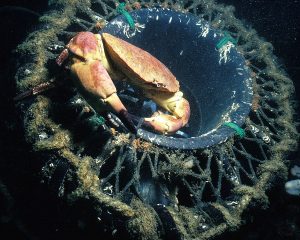
Crustacean byelaws that apply within the six-mile limit around Cornish shores are now under review.
Cornwall IFCA welcomes the national ban on the landing of berried lobsters, and understands that many are being returned to sea around the Cornish coast.
Principal enforcement officer Simon Cadman explained: “We are getting so many reports, through our shellfish returns from vessels around Cornwall, on the number of berried lobsters being returned. That has got to be good for the future of the lobster stocks – around Cornwall at least.
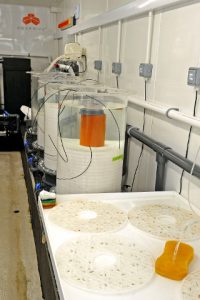
While there is no scientific proof that rearing and releasing juvenile lobsters is why the wild stock is improving, ‘it is difficult to think that it hasn’t helped’, says Simon Cadman.
“We appreciate that, at present, returning berried lobsters significantly reduces the catch returns for some fishermen, and many have seen a drop in their income – but hopefully that will be a short-term pain for a long-term gain, and those fishermen will catch those lobsters again, either later in the season or next year, when those lobsters have successfully spawned and grown.
“This is also another example of why monthly shellfish returns are so important. In some areas, a number of fishermen are catching more crawfish than they have for many years; some say that, at present, they are catching more crawfish than crab. The presence of more crawfish on the ground potentially spells good news for a future crawfish fishery, one that Cornwall had in previous years.”
The officers of Cornwall IFCA would like to see its minimum landing sizes (MLS) for lobster and crawfish extended beyond its jurisdiction of zero to six miles offshore.
Chief officer Sam Davis explained: “The national ban on the retention of berried lobsters is clearly welcome, as it sits alongside our current byelaw inside six miles, but we would like to see the minimum size of lobster under our byelaw (90mm carapace length) extended outside six miles – it is currently 87mm under the European MLS.
“While the difference between 87mm and 90mm may seem small, it is a vital measure from which, we believe, the Cornish stock has benefited.
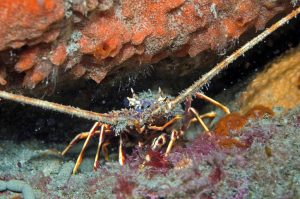
Crawfish of 95mm in carapace length are far too small, says Cornwall IFCA, which has an MLS of 110mm inside six miles.
“The MLS for crawfish caught inside six miles of the Cornish shores is 110mm (carapace length), but outside six miles it is 95mm, and that is a huge difference – those at a carapace length of 95mm are truly small crawfish. In our opinion, it is very important that such a difference should be addressed. We now have an increasing stock of small crawfish, and it would be so positive to see them protected, to get a chance of reaching the inshore grounds and breed before being taken. Allowing the crawfish to reach 110mm carapace length would help to enhance that stock.”
Cornwall IFCA has regular contact with the National Lobster Hatchery (NLH) at Padstow. NLH now has a satellite depot at Sandy Cove, Newlyn.
Although no direct evidence can prove that regular NLH releases of juvenile lobster are responsible for the upturn in the local stocks, ‘it is difficult to think that it hasn’t helped’, said principal enforcement officer Simon Cadman. “While we analyse as much data as possible, there are times when we cannot be 100% certain of the reason behind a stock change, but the data we receive on the shellfish permits helps to build up a picture of trends in landings.”
A ‘tool’ for future lobster farmers
Aftewr funding from the Marine Management Organisation (MMO) and European Maritime and Fisheries Fund (EMFF), a satellite Lobster Module at Newlyn now adds to the work carried out by the National Lobster Hatchery (NLH) at Padstow.

Hard at work at the Newlyn Lobster Module are hatchery technicians and marine biologists Ruth Cacharron Fernandez and Chris Weston.
Over the past 12 months, the Newlyn Lobster Module has produced more than 8,000 juvenile lobsters.
Opened in 2017, the unit is now run by hatchery technicians and marine biologists Ruth Cacharron Fernandez and Chris Weston. More satellite pods may, in time, be considered, says the NLH.
A spokesman from NLH said: “Satellite pods are essential in helping us to understand and improve production success. The ability to modularise our work has positive implications for both stock enhancement and on-growing mariculture. The Lobster Module at Newlyn is a demonstration project that is enabling us to examine the practical feasibility of operating essential onshore equipment and facilities to complement and supply
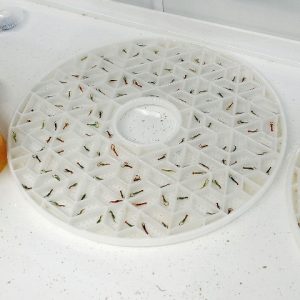
Having a mobile laboratory enables land-based ‘seed’ supply. Here, the juvenile lobsters – at the final larval stage (stage five) – are separated and kept individually in a stackable-disc unit, with each disc able to hold considerably more juveniles than the old style of box chambers.
offshore operations.
“Remarkable production at the Newlyn Lobster Module has enabled 8,000 juvenile lobsters to be either released into the wild or grown on in sea-based containers, as part of the NLH’s award-winning Lobster Grower 2 (LG2) research programme.”
Newlyn’s Lobster Module is at the forefront in rearing trials, and is examining a simple, mobile, modular and scalable system of land-based ‘seed’ supply. This can be located near to a lobster farm, or near to a lobster release site.
The spokesman added, “It will allow us to test and identify issues associated with deployment and operation, enabling us to create a toolkit for the lobster farmers of the future. This could also help deliver jobs and economic activity to coastal communities.
“We mainly work with local divers and fishermen to successfully release juvenile lobsters into the wild. A release-box is occasionally used to allow small-scale controlled releases directly from the fishermen’s pots.”
Newlyn’s Lobster Module is sited in portable ship containers – units fitted out internally to a high standard, containing advanced mariculture equipment.
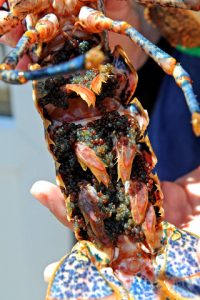
Knowing when the eggs are ready to hatch is a skill passed on to a number of Cornish fishermen, who have a permit to retain such berried lobsters, to pass them on to the lobster hatchery. This sample was shedding its eggs when photographed.
Being mobile, the Lobster Module at Newlyn is also testing and identifying issues associated with its deployment, and through the operation of a containerised module, it takes all external factors into account. By the completion of the project in 2019, a toolkit for future lobster farmers may be found.
“What we are developing will include the criteria by which future lobster farmers can identify and select the most appropriate sites and conditions,” NLH says.
Current techniques used by the NLH indicate that rearing the larvae through their early vulnerable stages leaves them better equipped to survive in the wild.
Its spokesman added, “In rearing them to even larger sizes in environmentally-enriched sea-based containers (through the NLH LG2 research project), juveniles are exposed to the kind of natural conditions that they will encounter following release into the wild, which may increase their chances of survival yet further.
“From its Newlyn Lobster Module facility, the NLH is currently releasing between 500 and 1,000 juvenile lobsters per week, a valuable addition to the lobsters reared and released from the main laboratory at Padstow.
“If this project proves successful, then, over time, it is hoped that the NLH will be able to bid for funding in order to establish more satellites along the Cornish coast, to further support the sustainability of the local lobster fishery.”
Cornwall’s live wrasse fishery may soon be controlled by Cornwall IFCA
Live wrasse fishing in Cornwall may soon be limited to five permits a year, with an administration fee of £135 each year.
The live wrasse permit scheme is one of two proposed new byelaws that were discussed at the Cornwall IFCA meeting on 25 June.
Principal enforcement officer Simon Cadman explained that, at the meeting, the authority made two byelaws: the Whitsand and Looe Bay Marine Conservation Zone (Fishing Restrictions) Byelaw 2018, and the Live Wrasse Fishing (Limited Permit) Byelaw 2018.
He said: “Those byelaws have been made by our authority members, but until such time as we carry out formal consultation with the public, and DEFRA is happy that each byelaw is workable, those byelaws are not yet in operation.
“Adverts announcing the consultation will be published from 5 July to 9 August in Fishing News, in local newspapers, and on our website: cornwall-ifca.gov.uk
“Everyone will have the chance to make their comments, and we will obviously take note of them all, and so will the MMO. It is important that we hear from all sides, stating their fears or giving their support. Results will be discussed by the IFCA committee, and if necessary, it may make amendments before the byelaws are sent for confirmation by DEFRA.
“The live wrasse byelaw has taken a considerable time to produce. It is a complex fishery, and after the Scottish salmon farmers saw that using wrasse to remove the lice from the salmon was a very efficient method, the fishery grew at quite a rate. Live wrasse fishing is going on in other IFCA regions, and so far, we are the second IFCA to introduce a byelaw to manage it. We are doing so in order for the Cornish fishery to remain a profitable long-term venture, and not get out of hand and have significant effects upon the region’s wrasse stocks.”
The new byelaw states that only five permits will be issued, and at first these will be prioritised to vessel owners who were active in the fishery – and have a proven track record – before 1 August, 2016.
Cornwall IFCA’s research officers have, for some time, carried out studies of live wrasse fishing on its research vessel, Tiger Lily, and have also spent time aboard active fishing boats, gathering data to underpin the proposed byelaw. Around seven boats were active in the fishery during the time period, but Cornwall IFCA believes that a few may have stopped fishing for live wrasse, and that five permits are, at present, sufficient to retain a viable fishery.
Simon Cadman added, “We will look at our evidence retrospectively, and the boats that have been in the fishery for the longest will be able to apply for a permit. Boats that were not involved in the fishery (before August 2016) can apply for a permit, but may have to go on a waiting list.
“All limitations and variations within the byelaw have taken a long time to evaluate, and so that we can closely monitor the fishery, each permit holder will have to supply monthly catch returns and fishing effort details. We are proposing seasonal closures on some species of wrasse, and one species cannot ever be retained.
“As an example, from January to March inclusive, the retention or landing of live ballan wrasse is not allowed, and during May and June, the same applies to goldsinny, rock-cook and corkwing wrasse. Retention or landing of cuckoo wrasse is prohibited at all times. However, cuckoo wrasse is not a species favoured by the salmon farmers.
“While all wrasse eat the lice to some extent, salmon farmers do prefer the use of ballan wrasse. After the wrasse have spent two cycles with the salmon, they have to be killed, which is standard practice, and because they have spent time in other waters, they cannot be brought back to Cornwall.
“We propose to prohibit live wrasse fishing in eight areas around the Cornish coast, which includes the whole of the north coast. Minimum sizes of wrasse have also been proposed, and the size and/or construction of pots or traps is also written into the byelaw.
“Other rules exist, like the dimensions of pot entrances, and the sizes of escape gaps. We have also written into the byelaw that if a permit holder does not comply with the regulations, Cornwall IFCA can withdraw the permit, or not issue a permit. And if evidence stacks up that the wrasse stock of a given area is under threat, we can reduce the number of permits issued, using flexible permit conditions in the byelaw. At the moment, a voluntary code of conduct is in place for the boats engaged in the fishery.
“The Whitsand and Looe Bay MCZ byelaw has been developed to protect seabed features in that marine conservation zone. The use of bottom-towed gear will be prohibited in a designated area covering about 80% of the whole MCZ, and also must not be below the surface of the water while the vessel is in that area.”
One stock becomes two – Cornish ring-netters under pressure
The fishery for Cornish sardines, which is targeted by 13 ring-net vessels, has agreed to a voluntary code of conduct, said Gus Caslake, chairman of the Cornish Sardine Management Association (CSMA). This has been signed off by all members. The CSMA is supported by the Seafish South West Advisory Group.

Gus Caslake, chairman of the Cornish Sardine Management Association (CSMA), is confident that sardine stocks are strong, and hopes that data supplied by CSMA provides a more realistic catch assessment.
Catches are currently landed into four processors based in Cornwall and Plymouth, all of which are members of the CSMA. The code of conduct includes a limit on the number of vessels, a vessel length limit of 15m, and a limit on the length of net used in the fishery. A catch limit per boat might be introduced for the forthcoming season, to stave off precautionary catch limits advised by ICES.
As the result of a fishery review, ICES split the advice on the sardine stock from the combined regions of Areas VII and VIII into separate catch advice for each area. ICES issued its precautionary advice for Area VII last year.
“While there was plenty of historical data available from the French and Spanish for Area VIII, data for Area VII was limited,” explained Gus Caslake.
“So far, catches of sardines from Cornish ring-netters remain small – around 7,000t per year, and just 10% or less of the combined ring-net catches of Areas VII and VIII. However, under single-region management, the Cornish catches may top 50% of the sardines available to ring-netters in Area VII.”
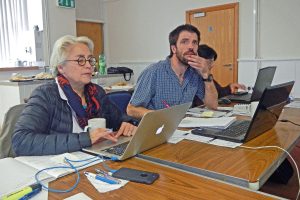
Members of the MSC present at the meeting with ring-netters this March. Left to right: Sophie Des Clers, Dr Hugh Jones and Dr Matt Cieri.
He added that, due to the lack of data available for Area VII sardines, ICES has taken a worrying ‘precautionary approach’ to assessment, and that any reduction in fishing effort as a result may be hard-felt by the ring-netters. “Our fleet has been working hard over recent seasons, with support from CEFAS, to improve the stock assessment, through all skippers engaging in the self-sampling of catches at sea. This data has been presented to ICES by CEFAS, but until ICES has the opportunity to reassess the stock information, we might be left with just 5,000t for the coming season.”
Moves by ICES to split the stock triggered a further study of the Cornish sardine fishery by the Marine Stewardship Council (MSC), and an ‘expedited audit and surveillance’ took place earlier this year.
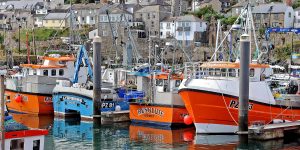
The fleet of West Country sardine ring-netters remains small, and is unlikely to expand further.
“It was not a reassessment of the fishery, but a review of the new information available. Cornish sardines still hold MSC accreditation,” said Gus Caslake.
“Because data on the sardine stock in the area we fish is seen as ‘data-deficient’, ICES advice is based on the precautionary approach, and to retain MSC certification, we have to go with that advice, and stay within the advised catch limits.”
Proudly won in August 2010, MSC accreditation of Cornish sardines has become the backbone of the fishery’s specialised wholesale and retail markets.
“MSC certification is very important to the Cornish sardine boats, and also to the processors. Having been running for eight years, we were recertified by the MSC in March 2017. However, four months later, ICES decided to split the sardine stocks into two, between Areas VII and VIII. Before that, in terms of catch data, it was a combined stock, running all the way from the southern end of Ireland to the southern end of the Bay of Biscay,” Gus Caslake explained.
“MSC certification is very important to the Cornish sardine boats, and also to the processors”
“Initially, we thought it would be a good thing in terms of management to split the stocks, because all our fish are caught close to the shore in Area VII – we catch approximately 50% of the fish landed from Area VII. However, when the stock was combined we were the small players, taking under 10% of the bigger total.
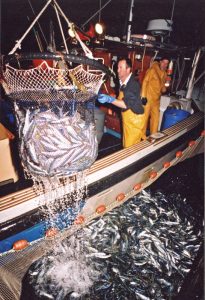
Ring-netting in its infancy in Newlyn, aboard Prue Esther. Skipper Sam Lambourn later invested in one of today’s advanced ring-netters, the 12m catamaran Lyonesse.
“The separation of the two areas leaves a poor deal for our boats, and in MSC score terms we were under threat of losing what to us is vital – our MSC certification. However, the data collected by the CEFAS Endeavour during the PELTIC survey, carried out since 2012, combined with our skippers’ self-sampling data, shows a healthy stock in Area VII – a stock of around 120,000t. From the MSC point of view, until this information is reviewed fully by ICES, the precautionary advice must be adhered to.
“The precautionary approach by ICES has assessed catch data over a three-year period (2014 to 2016 inclusive). Then, minus 20% as a precautionary measure, that leaves us with about 5,000t as the top figure – 2,000t short of our current catch levels.
“Through the MSC, we passed the ‘expedited audit and surveillance’ in March this year, though a number of conditions were set for the fishery over the coming seasons. One was to improve our logbooks on matters such as recording any interaction with sea birds and sea mammals. That is already in hand, and we have made a commitment to take observers onboard to monitor any interaction.
“The biggest issue for us is that to achieve another of the MSC conditions, we need to get within the ICES precautionary advice. This has proved a contentious issue, as the advice from CEFAS is that the sardine stock is healthy; skippers are seeing more sardines on the grounds than they have for many years. We are just waiting for ICES advice to catch up with the current state of the stock. In the meantime, we are subject to meeting the precautionary advice, or we risk losing our MSC certification.
“As part of the pelagic species study in the Celtic Sea (PELTIC survey), last year sardines in Area VII became part of the European Commission’s Data Collection Framework (DCF). Previously, the PELTIC survey only sampled part of Area VII. Under the DCF, all of Area VII, right up to the French coast, is now sampled. The data from the survey shows that Area VII sardine stocks look pretty healthy.
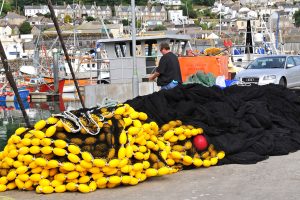
Sardine ring-netting is a small West Country fishery, but has brought considerable shore-work to the net-makers.
“From the DCF, for this year the suggested total stock of Area VII would be around 120,000t, from which about 20% would be taken as a safe catch level. That would mean 24,000t available for Area VII, so there is positive news. But because the data from the PELTIC survey is from a relatively short period, neither ICES nor the MSC will accept it as a truly underpinned figure. At present, the Area VII sardine stock is categorised as Category 5, and until a review is carried out, it remains at the lowest level.
“With the better data that we have from our skippers and processors, together with data from CEFAS, we will attempt to get the sardine stock of Area VII recategorised as Category 3, which means that the present biannual precautionary advice will become annual precautionary advice. From the data we now have, in our opinion, the available catch for the Cornish ring-netters might move up to 7,000t. But we might be limited to just 5,000t for this season, and although the fleet is small, it has grown slightly. A couple of new boats have joined, because fishing has been good.
“This season we will monitor the ICES advice, and have monthly returns submitted by our processors; we will hold a special meeting in September, just before the heavy fishing begins, to review where we stand against the ICES advice. We will do our best to rein in effort, to stay within the figure issued. And, in January, when we receive the precautionary advice for 2019, we aim to stay within those figures as well.
“It is key that we continue to improve the information on sardine stocks in our area, and we will continue voluntary sampling, and liaise closely with CEFAS through the FSP. We are confident that the stocks are strong, and can only hope that the data we supply to ICES will result in the Area VII sardine stock being assessed using the best available science, resulting in a more realistic catch assessment.”
Turning photos into paintings
From nothing more than a few photographs, Irish marine artist John Baird recently produced an impressive pen and ink canvas of the Newlyn beam trawler, William Sampson Stevenson. Capturing such detail without seeing the boat in person is a skill he began to develop in the 1950s, at 10 years of age.
A technique also used by other marine artists such as Toni Knights and Jess Douglas, producing work without seeing the craft is now a means for skippers far away to get an accurate portrait of their vessel.
John Baird said: “I started doing pictures over 50 years ago, and at that time, the schools in Co Donegal, where I grew up, didn’t take art seriously; there were no art classes.
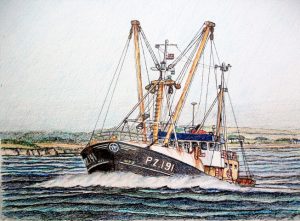
John Baird’s painting of the Newlyn beamer William Sampson Stevenson PZ 191 was produced from just a couple of photos.
“Born not many miles from Killybegs – and about the same distance from Greencastle – I began to watch Dutch coasters coming into Irish ports, and I started drawing them. When I got a bit older, but still as a kid, I started to swap the sketches for cigarettes. Later, I joined the merchant navy and started to work on such boats, first as a deckhand and then as a cook. I stayed for quite a few years, then came ashore, and eventually ended up joining the RAF, where I spent five years. After that, I went back on the coasters as a cook.
“I was still drawing all through those years, and tried a bit of painting too, but I didn’t like painting, it was not for me. From day one, I always used pen and ink, and I’ve stayed with that medium ever since. Using pen and ink gives me more opportunity to concentrate on detail, which I do, and that’s very important in my work. And sticking to detail is a technique that, as a marine artist, will never leave you.
“Sadly, over the past few years I have developed arthritis in both hands, which when you always stick to detail is not helpful, but I’m still able to work as normal for short periods. I was going to stop drawing last year, but The Irish Skipper printed some of my work, and I received plenty of interest from skippers, all over Ireland. Then I, like most marine artists, ended up having my own page on Facebook.
“From Facebook I started supplying work to fishermen on the south coast of England; shortly after that, I was getting orders from all over the UK, the Isle of Man, everywhere. And that’s where I am now. I have steady work, but I’m always interested in more.
“The work of Jess Douglas – where she doesn’t include the background – I admire a lot. I have seen her work and it is excellent, but my work is different; I do include the background, because to me, it becomes part of the story.
“Drawing Dutch coasters as a youngster was proof enough that when the Dutch build a boat, they do so with great lines – a lovely sweeping bow and a great whaleback, and right down the boat, those lines are right, a really beautiful boat. I just draw what I see; I don’t need too many pictures to imagine the subject, but, as always, the more photos of different angles that I get, the better. Having worked at sea, I have more than a fair idea of what it looks like in real life.
“I can see the boat in my mind, and deliver that in pen and ink. If the photographs were taken, say, before any radar was fitted, or there was any other change, just say so, and it will be included. That’s my life really; I was mostly into coasters, with Dutch coasters being my favourite, but fishing boats caught my eye a very long time ago, and that’s the direction I’m going in now. I would like to thank everyone for their support, and Jess Douglas in particular. She’s a hand-painter for whom I have a lot of admiration.”
John Baird’s work can be seen at: bit.ly/2NPXF8O
Free dentist in a van
Free dental treatment and health checks were offered around West Country fishing ports a few weeks ago, in a tour that began at Newlyn.
Backed by the Fishermen’s Mission and Seafarers’ Hospital Society (Dreadnought), the mobile service, named Smiles at Sea, had a good response, Fishing News was told.
Organisers explained: “The fishing community in Cornwall and Devon is hopefully now smiling, thanks to an initiative enabling local fishermen and their families access to free dental check-ups, and tips on oral health, at the harbourside.”
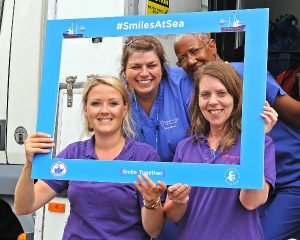
Smiles at Sea also gave a health check – for height, weight, body mass index, blood pressure and cholesterol – which was used to calculate the risk of developing heart disease, stroke, diabetes, kidney disease and dementia.
In a statement, the organisers of Smiles at Sea added that the Seafarers’ Hospital Society and the Fishermen’s Mission have hooked up with award-winning dental social enterprise Smile Together to offer free dental checks and follow-up treatment for local fishermen and their immediate family members, in six locations across Cornwall, and in Brixham in Devon.
Funded by the societies, the initiative saw volunteers from Smile Together embark on a two-week tour in a fully-equipped mobile dental unit. Following Newlyn, the tour moved on to Hayle, Newquay, Padstow, Mevagissey and Looe, before finishing in Brixham.
As part of National Smile Month, Smiles at Sea saw fishermen and their families screened for oral cancer, receive immediate dental treatment at the mobile surgery, and be entitled to subsidised follow-up private dental treatment, as recommended by the dentist on the day.
The Seafarers’ Hospital Society and the Mission funded the events, meaning that it was absolutely free for fishermen and their families, and any follow-up treatment that is required will also be paid for by the charities – all the patients need to do is pay a standard NHS contribution.
Lysanne Wilson, health development manager at the Seafarers’ Hospital Society, explained: “We’re delighted to be working with the Fishermen’s Mission and Smile Together to bring free dental health checks to fishermen and their families in Cornwall and Brixham.
“Dental health is just as important as physical and mental health, but when you’re out at sea, it’s often not a priority. We’re making it easy by bringing free dental treatment to the harbourside, so it fits around the fishermen and their busy working lives. By working in partnership with Smile Together and the Fishermen’s Mission, who closely support fishermen and their families, we can make a real and lasting difference to the fishing community. And if this initiative is successful, we hope to extend it even further in 2019.”



